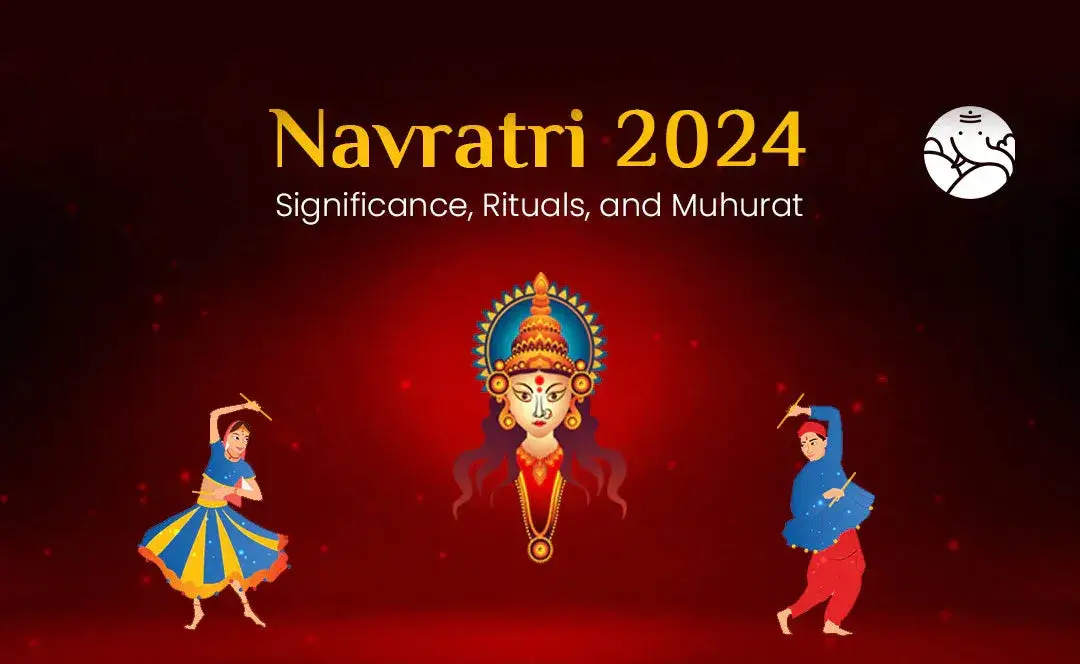Introduction
Shardiya Navratri, dedicated to the worship of Goddess Durga, is one of the most celebrated Hindu festivals. This nine-day festival marks the triumph of good over evil, as it commemorates Goddess Durga’s victory over the demon Mahishasura. In 2024, Shardiya Navratri begins on October 3rd and ends on October 12th. This blog will provide a detailed guide on the dates, rituals, significance, and more to help you prepare for and celebrate this auspicious festival.
Dates and Key Rituals
Shardiya Navratri 2024 Dates:
- Start Date: October 3, 2024
- End Date: October 12, 2024 (Dussehra)
Key Rituals and Muhurats:
| Date | Ritual | Details |
|---|---|---|
| October 3 | Ghatsthapana | Morning 6:15 AM – 7:22 AM |
| October 4 | Worship of Maa Brahmacharini | Second day of Navratri |
| October 5 | Worship of Maa Chandraghanta | Third day of Navratri |
| October 6 | Worship of Maa Kushmanda | Fourth day of Navratri |
| October 7 | Worship of Maa Skandamata | Fifth day of Navratri |
| October 8 | Worship of Maa Katyayani | Sixth day of Navratri |
| October 9 | Worship of Maa Kalaratri | Seventh day of Navratri |
| October 10 | Worship of Maa Mahagauri | Eighth day of Navratri |
| October 11 | Worship of Maa Siddhidatri | Ninth day of Navratri |
| October 12 | Dussehra | Celebration of Goddess Durga’s victory |
Significance of Shardiya Navratri
Shardiya Navratri holds great importance in Hindu mythology. It is believed that during these nine days, Goddess Durga fought and defeated the demon Mahishasura, symbolizing the victory of good over evil. Each day of Navratri is dedicated to a different form of the Goddess, and devotees observe fasts, perform rituals, and engage in devotional practices to seek her blessings.
Statistical Insight:
- Around 80% of Hindus in India participate in Navratri celebrations, making it one of the largest religious festivals in the country.
- During Navratri, approximately 70% of households in states like Gujarat and West Bengal set up community pandals for worship and festivities.
Rituals and Practices
1. Ghatsthapana:
- The festival begins with Ghatsthapana, a ritual to invoke the Goddess. A pot is placed in the puja room, symbolizing the universe, and it is filled with water, flowers, and other sacred items.
2. Daily Worship:
- Each day of Navratri is dedicated to a different form of Goddess Durga. Devotees perform pujas, chant mantras, and offer prasad specific to each form.
3. Fasting:
- Many devotees observe fasts during Navratri. Some consume only fruits and milk, while others follow a strict vegetarian diet without grains and salt.
4. Dandiya and Garba:
- In states like Gujarat, traditional dances like Dandiya and Garba are performed in the evenings. These dances are not only a form of worship but also a way to celebrate the community spirit.
The Forms of Goddess Durga
Each day of Navratri is associated with a different avatar of Goddess Durga:
- Maa Shailputri: Worshipped on the first day, representing nature.
- Maa Brahmacharini: Worshipped on the second day, symbolizing penance and austerity.
- Maa Chandraghanta: Worshipped on the third day, known for peace and tranquility.
- Maa Kushmanda: Worshipped on the fourth day, associated with vegetation on earth.
- Maa Skandamata: Worshipped on the fifth day, the mother of Skanda (Kartikeya).
- Maa Katyayani: Worshipped on the sixth day, a warrior goddess.
- Maa Kalaratri: Worshipped on the seventh day, who represents the dark night.
- Maa Mahagauri: Worshipped on the eighth day, symbolizing purity and serenity.
- Maa Siddhidatri: Worshipped on the ninth day, the giver of supernatural powers.
An Analogy to Understand Navratri
Consider Navratri as a spiritual detox. Just as a physical detox clears out bodily toxins and rejuvenates health, Navratri cleanses the mind and soul, providing spiritual rejuvenation. Through fasting, prayer, and reflection, devotees purify their hearts and strengthen their faith, emerging spiritually refreshed and empowered.
FAQs about Shardiya Navratri
Q1: What is the significance of Ghatsthapana in Navratri?
A1: Ghatsthapana marks the beginning of Navratri. It involves invoking Goddess Durga’s presence in a pot filled with water, grains, and other sacred items. This ritual symbolizes the universe and seeks the Goddess’s blessings for the nine-day festival.
Q2: Can anyone observe the Navratri fast?
A2: Yes, anyone can observe the Navratri fast. The fasting rules can vary, but generally, devotees avoid grains, non-vegetarian food, and certain spices. Some may consume only fruits and dairy, while others follow a simple vegetarian diet.
Q3: What is the cultural significance of Dandiya and Garba during Navratri?
A3: Dandiya and Garba are traditional dances performed during Navratri, especially in Gujarat. These dances are a form of worship and celebration, bringing communities together to honor Goddess Durga through rhythmic movements and music.
Q4: Why is Shardiya Navratri considered more significant than other Navratris?
A4: Shardiya Navratri, occurring in the autumn, is considered the most significant because it marks the victory of Goddess Durga over Mahishasura, symbolizing the triumph of good over evil. It is also more widely celebrated across India, with grand festivities and rituals.
Q5: How do devotees prepare for Navratri?
A5: Devotees prepare for Navratri by cleaning their homes, setting up altars for the Goddess, and gathering necessary items for rituals and pujas. Many also plan their fasts and dietary changes in advance to fully participate in the festival’s spiritual practices.
Conclusion
Shardiya Navratri is a time of profound spiritual significance, cultural celebration, and communal harmony. As devotees across India prepare to honor Goddess Durga, they engage in rituals, fasts, and dances that reinforce their faith and bring communities together. By understanding the dates, rituals, and significance of this festival, we can fully appreciate its importance and partake in its celebrations with devotion and joy.
For more tips and information on Indian festivals and cultural practices, visit TopIndiaTips.com.
